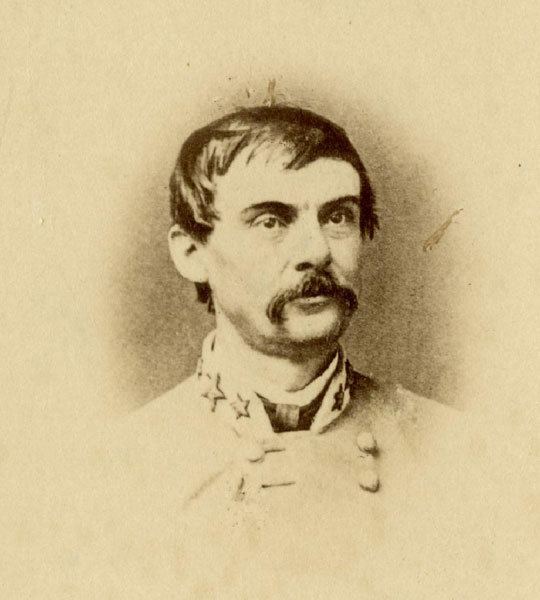Years of service 1861–65 Rank Brigadier General | Name John Echols Children Edward Echols | |
 | ||
Born March 20, 1823Lynchburg, Virginia ( 1823-03-20 ) Battles/wars American Civil WarFirst Battle of Bull RunValley CampaignBattle of Droop MountainBattle of New MarketSiege of Petersburg Similar People William W Averell, Robert E Lee, Ulysses S Grant | ||
Leticia ferrer wife of john echols eulogy at viewing mov
John Echols (March 20, 1823 – May 24, 1896) was a general in the Confederate States Army during the American Civil War.
Contents
- Leticia ferrer wife of john echols eulogy at viewing mov
- Droop Mountain Memorial March HD 1080p
- Early and family life
- Early legal and political career
- Confederate service
- Postwar career
- Death and legacy
- References
Droop Mountain Memorial March HD 1080p
Early and family life
John Echols was born in Lynchburg, Virginia, and was educated at the Virginia Military Institute, Washington College and at Harvard College. A tall imposing man, standing 6 feet 4 inches tall, Echols quickly became a leader among his peers. Echols married twice. His first wife was a sister of Senator Allen T. Caperton (also of what became West Virginia). After she died, he married Mrs. Mary Cochrane Reid of New York.
Early legal and political career
On becoming a lawyer in 1843 he settled in Union, Monroe County (now West Virginia). Echols represented Monroe County in the Virginia House of Delegates 1852–1853 and in the Virginia Secession Convention of 1861.
Confederate service
Both Echols and Allen T. Caperton voted for Virginia's secession from the United States on April 17, 1861 at the Richmond convention. When the secession ordinance was put to public vote on May 23 Monroe County voted 1,085 to 79 in favor of secession. Echols offered his service to Virginia. He gathered a group of volunteers and was commissioned as a lieutenant colonel. On May 6, 1861, General Robert E. Lee ordered Lieutenant Colonel Echols to call out and muster in volunteer forces, not to exceed two regiments, to rendezvous these men at Staunton for Joseph E. Johnston's fledgling army.
Echols was then assigned command of the 27th Virginia Infantry, leading the regiment in the fighting at the First Battle of Manassas under Stonewall Jackson. He was soon promoted to colonel, serving in the Valley Campaign. He was severely wounded on March 23, disabling him for several weeks. Echols was promoted to brigadier general on April 16, 1862 during his convalescence.
Later in the year, he was assigned to command a brigade of the army of Western Virginia. He participated as a brigade commander in William W. Loring's occupation of the Kanawha Valley in September. After Loring withdrew to the mountains, Echols replaced him in command of the Department of Western Virginia. He promptly reoccupied Charleston, but was forced to retreat by a superior enemy force.
Echols resigned his departmental command in the spring of 1863, and, during the following summer, served upon the three-man court of inquiry held in Richmond to investigate the cause of the fall of Vicksburg. Later in the year, he commanded the Confederate forces in the Battle of Droop Mountain, stubbornly resisting a series of Federal attacks. In May 1864, he commanded John C. Breckinridge's right wing at the Battle of New Market in the Shenandoah Valley.
General Robert E. Lee recalled Echols' Brigade was recalled to rejoin the Army of Northern Virginia near Cold Harbor during the Siege of Petersburg. On August 22, 1864, he was given charge of the District of Southwestern Virginia, and on March 29, 1865, Echols was assigned command of the western department of Virginia, relieving General Breckinridge, who had joined the staff of President Jefferson Davis. On April 2, Echols, with nearly 7,000 men, began a hasty march to unite with Lee.
He reached Christiansburg, Virginia, on April 10, where he received a telegram announcing Lee's surrender at Appomattox Courthouse. At a solemn council of war, Echols decided to march to unite with Johnston's army, and Echols led two brigades southward towards North Carolina. Subsequently, he accompanied President Davis to Augusta, Georgia.
Postwar career
Monroe County had been included in the new state of West Virginia without its consent and the new state government would not allow ex-Confederates to practice law. After the war, Echols resumed the practice of law in Staunton. He helped select the members of the Committee of Nine, a group of state leaders who worked to ensure that the state be readmitted into the Union and former Confederates could once again hold political office.
Echols returned to the Virginia House of Delegates 1878–1881, representing Staunton and Augusta County. While there, he sided with the Funders against the Readjusters, which briefly reunited Republicans and liberal Democrats, and tried to allocate some of Virginia's massive wartime debt to West Virginia and had supported Reconstruction.
He rebuilt his fortune and became President of the Staunton National Valley Bank. When the hastily agglomerated Chesapeake, Ohio and Southwestern Railroad went bankrupt, he became its Receiver and General Manager. He lived in Kentucky the last ten years of his life as he managed the railroad's affairs.
Death and legacy
He died at Oakdene the residence of his son, Edward Echols (later lieutenant governor of Virginia), at Staunton, where he is buried in Thornrose Cemetery.
